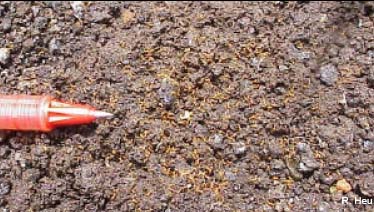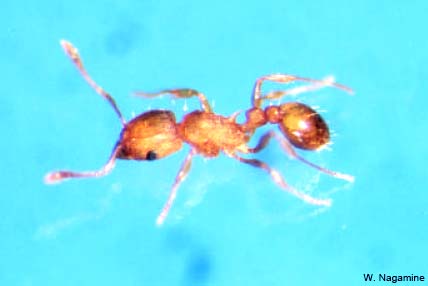Little Fire Ants Found in Forested Area of Nāhiku, Maui
By Maui Now Staff
A new infestation of little fire ants has been confirmed in a large forested area of Nāhiku in East Maui. Authorities say the infested area covers at least 20 acres along the Hāna Highway, according to initial estimates.
The discovery was announced today by the state Department of Agriculture and was reported on September 18th by crews from the Maui Invasive Species Committee.
State officials say MISC crews were working on the eradication of the invasive miconia plant in the area when workers reported being repeatedly stung by ants.
Personnel from the state Department of Agriculture on Maui gathered samples in the area yesterday, and department entomologists on Maui and Oʻahu made the confirmation today.
Three agencies, the HDOA, MISC and the Hawaii Ant Lab, are working on further surveys to better determine the area of infestation and develop treatment plans for the site.
“With such a large, heavily infested area, the crews will have to develop treatment plans and activities appropriate to the area,” said Dr. Neil Reimer, administrator of HDOA’s Plant Industry Division in a department press release.
“The area appears to be rough terrain, so safety of the crews will also be considered,” he said.
The Little Fire Ant, or LFA for short, is a native of South America, and is considered among the world’s worst invasive species.
The ants measure just 1/16th of an inch long, are pale orange in color, and have a larger head in proportion to their body.
Agricultural officials say the LFA can produce “painful stings and large red welts and may cause blindness in pets.”
They have been known to build up large colonies on the ground, in trees and other vegetation, and buildings and homes and completely overrun a property, according to the HDOA.
The state Department of Agriculture released the following chronology of the Little Fire Ant in Hawaiʻi:
- LFA has been found on Hawaiʻi Island since 1999. By the time it was identified, the ant population was deemed too widespread for eradication efforts.
- October 2009 – LFA was detected on a farm in Waiheʻe, Maui. The infested area involved about 1/2 acre and eradication efforts appear to have been successful and monitoring continues.
- December 2013 – LFA was detected on hapuu logs (Hawaiian fern) at retail stores on Maui and Oʻahu. Since its detection, Oʻahu and Maui nurseries have been surveyed. Seven Oahu nurseries, three of which were in Waimanalo, were found to have small infestations of LFA, the areas were treated and are clear of the ants.
- May 2014 – crews began treating a 6-acre area in Waimanalo, which included a 3.5 acre infestation area and buffer zone. Crews continue to conduct follow-up treatments at the Waimanalo site.
- June 2014 – a six-acre residential area in Mililani was found to be infested with LFA and treatment of that area is also on-going.
- July 2014 – A routine survey for LFA by members of the MISC detected a small infestation at a hotel in Wailea, Maui. MISC reported it found one LFA ant at a neighboring hotel. The landscaped areas are continuing to be treated and monitored.
- July 2014 – Maui HDOA inspectors found LFA on some of 51 hāpuʻu logs from Keaʻau, Hawaii Island. Although the logs were bait-tested for LFA in Hilo and after it reached Maui, LFA was not detected in the bait traps. However, upon closer visual inspection, Maui inspectors saw what looked like LFA, which was confirmed by entomologists. The logs were frozen to kill any LFA. Inspectors trace forward two other shipments from the source. They tested 100 logs and found LFA on seven logs. The area was also surveyed and no LFA was detected. Enhanced inspections at both departing and receiving ports have been established.
- August 2014 – Maui HDOA inspectors doing enhanced inspections found LFA on specialty pineapple transported from Hawaiʻi Island. The LFA were difficult to detect in the crown of the pineapple. HDOA inspectors continue to closely monitor similar shipments interisland.
Suspected invasive species should be reported to the state’s toll-free pest hotline at (808) 643-PEST (7378).













